Update: Animal Agriculture Exacerbates Human Inequality
A previous post mistakenly measured waste produced by slaughterhouses and meat processing facilities rather than the livestock farms themselves. What follows is an updated version of this post and code that measures livestock waste as intended in calculating disparities in class and race.
Waste from industrial animal agriculture is concentrated in the poorest areas of America, affecting the health of marginalized people.
Since 2015, many local and national news sources have discussed the relationship between hog agriculture and the health of the residents of Duplin County, North Carolina. Yet there is not much genuine news: documentaries have been discussing how industrial hog farms hurt local health as early as 1994.
The industrial farms of Duplin dispose much of their hog manure by creating lagoons full of waste. While legal, this method of disposal is unsanitary for neighboring communities, and dangerously vulnerable to disasters. In April 1999, 1.5 million gallons of hog waste leaked into a nearby creek and swamp. In 1996, 1999, and 2016, Hurricanes Fran, Floyd, and Matthew each drowned thousands of hogs and washed their waste out of lagoons and into water supplies, causing billions in damages.
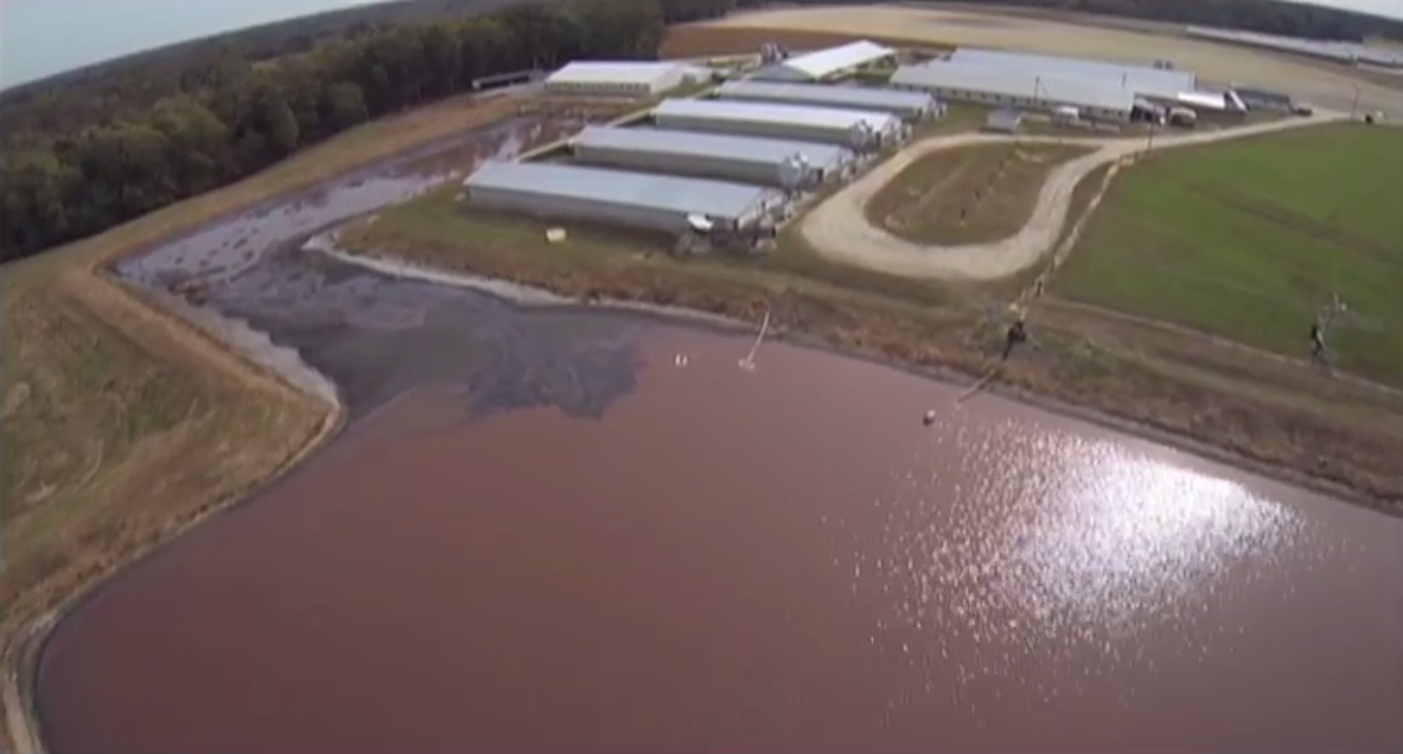
The burden of North Carolina's hog waste is borne by communities that are poorer, nonwhite, and more likely to depend on well water than their non-polluted counterparts. These communities have higher rates of health problems, such as asthma in children, increased blood pressure, and poor respiratory health. Neighbors of hogs farms report experiencing nausea and vomiting after inhaling offensive odors, preventing them from enjoying life outside.
In 2000, epidemiologists Steve Wing and Susanne Wolf published a study concluding that in North Carolina, "residents in the vicinity of the hog operation reported increased occurrences of headaches, runny nose, sore throat, excessive coughing, diarrhea, and burning eyes as compared to residents of the community with no intensive livestock operations." Despite this, recently enacted North Carolina legislation protects pork industry by limiting 270,000 property owners' right to be compensated for damage to their health and quality of life.
Animal agriculture workers suffer.
Waste lagoons are also dangerous to those who work near them. In 2004, two workers died when overcome by fumes from a dairy facility lagoon. In 2007, four members of a family and an employee died the same way in another dairy waste lagoon. In 2015, toxic gasses from hog manure killed two pairs of fathers and sons who were working around them. Livestock farm workers have unexpectedly high mortality rates for hypersensitivity pneumonitis, tuberculosis, asthma, and influenza. 58% of laborers in hog confinements experience chronic bronchitis.
Which communities experience the burden of animal agriculture pollution?
While community relationships between animal agriculture waste, income, and race are particularly well studied in North Carolina, and similar relationships exist in other areas too, they have not been examined on a national scale. This article examines communities near waste-producing animal agriculture facilities by using government-collected data.
The racial makeup, aggregate personal incomes, and location of each census block group was obtained from the National Historical Geographic Information System. 2011-2015 5-Year Estimates from the American Community Survey (ACS) were used. Aggregate personal incomes of each block group were divided by the total block group population and adjusted to determine Block Group Income Percentile. The percentage of white residents in each block group was adjusted to determine a Block Group White Percentile, which quantifies the presence or absence of people of color in areas relative to each other.
Facility waste release data came from the Environmental Protection Agency's Toxic Release Inventory (TRI), and animal agriculture facilities were examined. For each facility, the total waste amount is the sum of pounds of waste that were either released or treated on site in 2011-2015. Using longitude and latitude coordinates, distances between block groups and facilities were calculated. Based on previous research examining race and proximity to industrial hog operations in North Carolina, block groups were considered to be close to a waste producing facility if such a facility was within 3 miles of that block group's latitude and longitude.
More waste-producing animal agriculture facilities are near poorer and less white communities.
The following charts use linear regressions to examine block groups that are within 3 miles of animal agriculture facilities that are registered as having produced waste between 2011 and 2015.
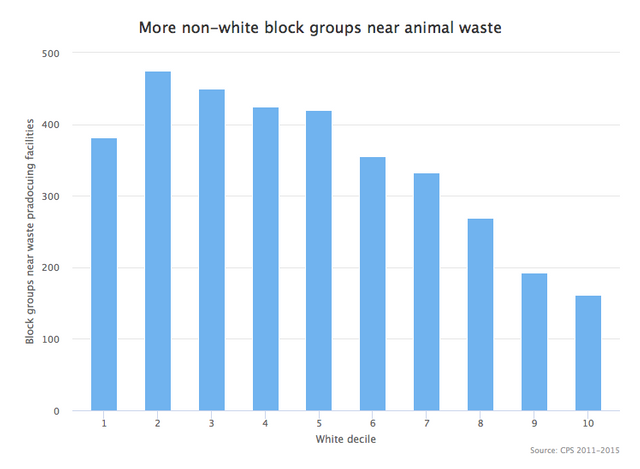
Waste-producing animal agriculture facilities are more likely to be in less white areas. Chart lines show predicted fit alongside 95% confidence intervals.
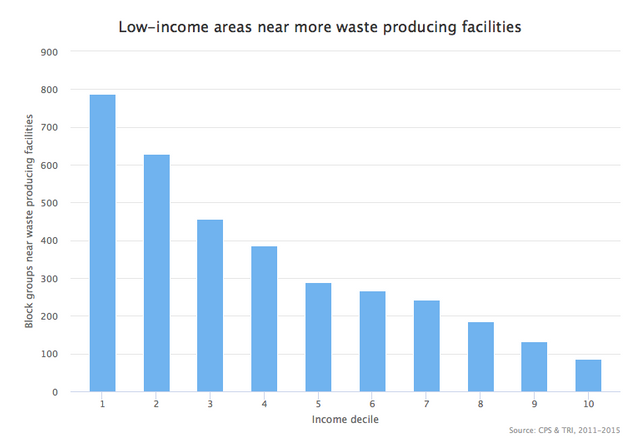
There is a similar trend with income, as waste-producing facilities are more likely to be in poorer areas.
While these trends are strong, they do not take the amount of waste produced by each facility into consideration, which is a limitation since different facilities could potentially produce dramatically different amounts of waste.
The amount of waste proximal to each block group within 3 miles of a a waste-producing animal agriculture facility will be calculated by multiplying the amount of pounds of waste produced by each facility in 2011-2015 by 3 minus the distance of that facility to the latitude and longitude of the census block group and summing the numbers.
For example, a census block group that is 0.00 miles from 1,000 pounds of waste would register as having 1,000 pounds of waste, while a census block group that is 2.75 miles from 1,000 pounds of waste would register as having 250 pounds of waste. This is intended to be an approximation of the amount of waste that might affect a community, and is unlikely to be entirely accurate since it assumes a linear relationship between waste and distance.
More animal agriculture waste is in poorer communities.
First, white/non-white distribution of waste will be examined.
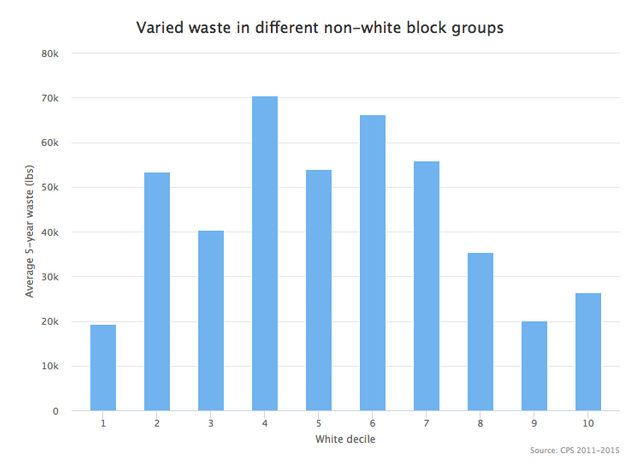
This contrasts the suggestions from the previous chart and suggests that on a national level, there is not a significant relationship between local waste quantity from animal agriculture and white/non-white communities.
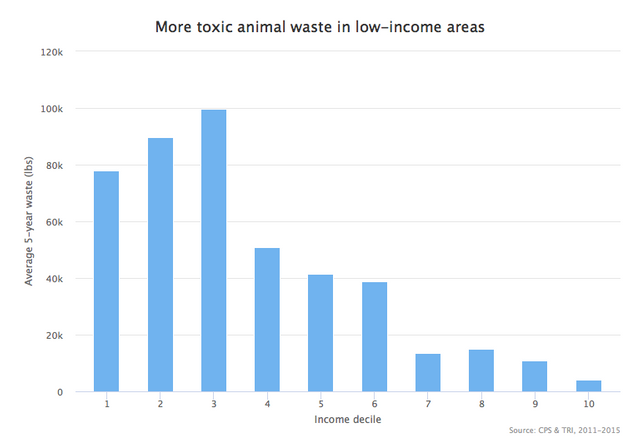
Animal agriculture facilities deposit more waste into lower-income areas.. Disproportionately more waste is created by animal agriculture in poorer communities, while little to no waste exists near the wealthiest areas of the US.
Industrial animal agriculture is a disaster for marginalized people.
The largely industrialized practice of animal agriculture in the United States adversely affects the health of large numbers of poor communities, non-white communities, workers, and animals. In a predictable intersection, powerful businesses that depend on systematic animal abuse for profit also abuse the rights of marginalized groups, such as poor communities and workers, in the process. Conversations about animal agriculture must consider the dominating class trends of animal pollution, and the poisonous effects of unchecked waste on human lives.
All code used to process data and create graphs is on GitHub.

Dear @somethingburger,
you've created this post with tags #utopian-io and #analysis, which made it appear in the Utopian post review feed. Unfortunately, your topic does not fit very well with Utopian, so it cannot be considered for a potential @utopian-io vote. Utopian is about incentivizing and rewarding work on open source project. The analysis category, in particular, is meant for analyses of open source projects which, in the best case, help the project owner in decision making. If you would like to learn more about Utopian check out https://join.utopian.io and/or join us on Discord.
#steemstem could maybe be an option for you?
Need help? Write a ticket on https://support.utopian.io/.
Chat with us on Discord.
[utopian-moderator]
Thank you for your review, @crokkon!
So far this week you've reviewed 2 contributions. Keep up the good work!
Hey, @somethingburger
Thank you for your contribution
Congratulations on your first contribution to Utopian!Upvote chronicled's comment to Support!
[Disclaimer: This is not official info from utopian , If you feel something need to improve please comment here]